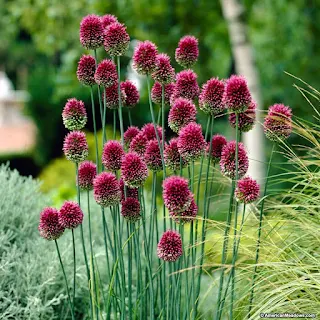 |
| Purple Drumstick Allium (Allium sphaerocephalon) |
We have three orchards around our property. One is between the road and the house and is primarily pears. One is out-back and is known as The Sahara Forest.
The third orchard is our "serious" orchard. It is southwest of the house and on the highest part of our property and is mostly apples on semi-dwarf rootstocks. Over time the layout mutated and we had trees die. It got to the point were I either had to rejuvenate it or put it out of its misery.
I decided to rejuvenate. I extended the footprint to the west. I had been growing grapes but never seemed to harvest them. Care of grapes was very different from how apples are managed. I decided I liked apples better. Apples pay their rent.
The last census of the Serious Orchard had 51 trees. Some of them are rootstock awaiting grafting. Relatively few have filled their allotted space.
The question we are gnawing on today is what to plant as ground cover.
Between the rows it will be a mix of grass and white/ladino clover. You cannot beat sod for providing a firm surface for driving and walking over.
The question is, "What to plant between the trees in the row?"
Immediately adjacent to the trees there will be mulch and/or herbicide cleared surface.
I hate seeing all of that sunshine falling on nothing.
The candidates are
 |
| Strawberry. Edible!!! Spreads rapidly. The perfect height and not too competitive with trees. |
 |
| Violets (Viola odorata) Edible. Smell nice. These had flower buds on March 12. This species is not native but there are many native species. This species is almost evergreen, however, and that gives is a headstart in the spring. |
 |
| Nodding Onion (Allium cernuum) Edible. Very small bulbs. Similar to chives. |
 |
| Wild Garlic. This list is heavy on onions (Allium) because they green up early in the season, are shade tolerant, deer resistant and all parts are edible. |
 |
| Purple Drumstick Allium. Edible 2" diameter bulbs. Not native. Image from HERE |
 |
| Ground Ivy (Glechoma hederacea). Aggressive. Not native. Already in orchard. |
 |
| Nettles. Already growing in orchard. Stings. Very competitive with trees due to deep, fiberous roots and the height of the stems. |
 |
| Motherswort (Leonurus cardiaca ) Already growing in orchard. Good bee plant. Too tall. |
 |
| Dwarf iris, Lovesick Blues Fragrant. $9 a rhizome. Prefers more sunnier spots. Image from HERE |
 |
| Common Daylily. Triploid (seedless) form. Spreads aggressively. Edible. Tall. Image from HERE |
 |
| Buckwheat. Great nectar plant for parasitoid wasps. The difference between a parasitic and a parasitoid wasp is that "-oid" wasp always kills the host. The only annual on this list. Can self seed. |
 |
| Wild Geranium (Geranium maculatum). Native. Not edible. Image from HERE |
One of the incidents that initiated this train of thought is a conversation I had with a lady in a grocery store. She was about my age. Had been born in Germany. Her father died when she was seven. WWII was still felt in the countryside. She grew up hungry. One comment she made in passing was that the Dutch survived by eating tulip bulbs.
If you are making an effort to grow something, why not choose plants that can feed you should the need ever arise?
What a difference a day makes.
Most of the photos shown above were taken on my property on March 12. This is what it looks like today.

It will be interesting to see who wins...
ReplyDeleteI seeded white clover in my orchard thinking it would attract pollinators to the trees. Turns out the trees finish flowering long before the clover flowers. Oops. Still, it's a great ground cover that only needs mowing 3 times a year.
ReplyDeleteCommon garlic grows well and can be divided every year. Same with day lilies. Roses are tough as nails and the hips provide vitamin C. I also have golden raspberries in the orchard. I transplant the escapees to the wood edge. They are prolific and don't have thorns and taste great. Very little trouble and the fruit is worth it.
Egyptian onions aren't onions or Egyptian but are vigorous, edible and perennial. You also might drop a few straw bales in there and plant potatoes in them (after a dose of nitrogen). Best way to grow spuds ever and zero hassle. The straw lasts for 2-3 years.